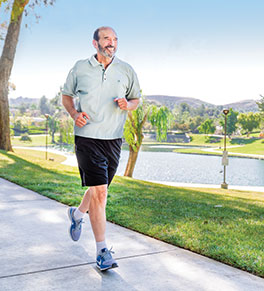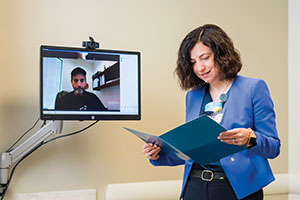Glioblastoma patients have options

Glioblastoma survivor Daniel Boyd, who placed his trust in UCI Health to treat his aggressive brain tumor, is back to running four miles a day.
Few people want to devote their lives to problems that seem nearly impossible to solve. UCI Health brain tumor expert Dr. Daniela Bota does so gladly.
Bota, medical director of the UCI Health Comprehensive Brain Tumor Program and the UCI School of Medicine's vice dean for clinical research, is a nationally recognized researcher leading the fight against one of the deadliest forms of brain cancer, glioblastoma.
This aggressive disease affects about 200,000 people a year, and it has taken the lives of U.S. Sen. John McCain, former Vice President Joe Biden’s son Beau Biden and rock drummer Neil Peart, to name a few.
Promising results
Bota has been conducting groundbreaking research on brain tumors, especially glioblastoma, for more than a dozen years, using various drug therapies and patients’ immune systems to combat this virulent cancer. Now, she says, she’s seeing real progress.
She is especially encouraged by such patients as Daniel Boyd, a 65-year-old Chino Hills resident who was diagnosed with a stage IV glioblastoma after experiencing vision problems.
“I was sitting at my desk one day, and all of a sudden my sight just got kind of strange, almost like I was looking through a kaleidoscope,” explains Boyd, the father of eight adult children ranging in age from 21 to 40. “Then I started to lose my right peripheral vision. Sometimes a group of three people would walk toward me and I could only see two of them.”
Before the vision problems, Boyd endured a difficult few years. His home burned in 2017, and he separated from his wife the following year. Still, he suspected his vision issues couldn’t be chalked up to stress. “I knew something was wrong, so I went to an ophthalmologist who said I needed an MRI right away.”
Meeting a neurosurgeon
The imaging scan revealed a brain tumor. Boyd got the news just after Thanksgiving in 2018. He saw a specialist at City of Hope in Duarte, Calif., where he was set to have treatment, until fate intervened.
He had mentioned his diagnosis to a church friend, who urged him to meet with another friend before doing anything else. The friend-of-a-friend was UCI Health neurosurgeon Dr. Frank P.K. Hsu.
“Honestly, at that point I left it up to my children,” admits Boyd. “They’ve been very successful — a federal agent, a Berkeley grad, a chemical engineer. I told them I think they’re a lot better at making decisions than their dad is and I’d go with their recommendation.”
After the Boyd children met with Hsu and heard about Bota’s successes with clinical trials, they unanimously agreed UCI Health was his best option.
The construction company controller believes his children’s judgment changed the course of his illness. Typically, glioblastoma patients have a recurrence within five to seven months and a life expectancy of about 12 to 18 months with the standard-of-care treatment — tumor removal surgery followed by chemotherapy and radiation.
Enrolling in a clinical trial
Instead, Boyd would be joining an immunotherapy clinical trial for which Bota is the lead investigator. AIVITA Biomedical is the Irvine-based company behind the therapy, which uses the patient’s own immune cells to create a vaccine.
Within 12 days after diagnosis, Hsu surgically removed the tumor. Boyd was home by the Sunday before Christmas 2018. “Brain surgery sounds really serious, but actually I didn’t feel bad afterward,” he says. “Part of that had to be because everyone at UCI was incredible. They instill confidence and really make you feel at home.”
A week after surgery, Boyd returned to UCI Medical Center for a day-long procedure to begin cell therapy. “Essentially, they take all your blood out, spin out the white blood cells and give your blood back to you. It’s kind of a recirculating process.”
Supercharging the immune system
The technical term is leukapheresis and it is a step in building a vaccine tailored to Boyd’s particular type of glioblastoma. His excised tumor, along with his white blood cells, helped researchers create an individualized immunotherapy treatment — essentially a supercharged version of his own body’s immune response — to fight the cancer.
Next he underwent six weeks of Monday-through-Friday radiation followed by several months of chemotherapy, then eight injections of his immunotherapy vaccine, spaced about a month apart.
“The great part of this treatment is that it has no significant side effects,” Bota says. “Patients in the trial are doing quite well as compared to other patients [not in the trial].”
AIVITA Biomedical recently released an update on Phase 2 of the clinical trial. The analysis of the results from eight study sites — including UCI Health — and a total of 55 patients, the overall survival rate at 15 months was 76% among patients who received immunotherapy compared with 48% in patients who received just radiation and chemotherapy after surgery. Bota and other researchers are now working toward a Phase 3 trial designed to test the safety and efficacy of the therapy with a larger number of patients.
“A lot of what we are focused on, what we are having very good results with, involves teaching a patient’s own immune cells how to fight the cancer,” she says. “We’re looking at some very safe, highly personalized treatments.”
Crossing the blood-brain barrier
Bota’s work on the experimental drug marizomib also has generated impressive results. Unlike traditional chemotherapy drugs, marizomib can penetrate the blood-brain barrier — the filtering mechanism that prevents most substances from passing into our brain tissues. The drug has shown it can inhibit cancer without causing damage to other parts of the brain.
Over the past 12 years, Bota has shepherded marizomib from preclinical development to the Phase 3 clinical trial now underway with 700 patients in five countries.
Amanda Johnson, a 33-year-old freelance writer in Mission Viejo, has been receiving marizomib for more than two years under Bota’s care. Her glioblastoma tumor — which straddled both sides of her brain — has shrunk so much that it’s no longer measurable and Johnson has returned to her pre-cancer life.
While there is always a careful screening process to determine if a patient meets the eligibility requirements for any clinical trial, Bota says UCI Health now has a “portfolio of options” to offer glioblastoma patients — which makes her ecstatic.
When the neuro-oncologist first started her research, glioblastoma treatment options didn’t exist. Few of the potential therapies that showed promise in early phase studies ever made it to Phase 3. No longer.
'A new era'
“It’s a new era for glioblastoma patients," she says. "A lot of us are working on this, and I absolutely feel confident that breakthroughs are coming. We are finding better ways to treat this disease. That’s what keeps us going.”
It has been more than 18 months since Boyd's cup-sized tumor was removed. While examining his latest brain scan at a recent appointment, Bota expressed amazement at finding no sign of active cancer cells. "She was elated and said, 'I don't get to see this very often. Dan this looks perfect, beautiful!'"
Surprised, he asked if she meant that or was just trying to make him feel good. Instantly serious, Bota responded, "I do not kid about this stuff." Humbled, he says it filled him with confidence to "know that this person cared so much about me and was absolutely straight with me.”
Although it may take a decade before clinical trial results definitively prove the efficacy and safety of his treatment, Boyd is grateful to be walking or running four miles a day again and enjoying his children and five grandchildren.
“My tumor was stage IV," he says in wonder. "I’ve been told it's a miracle I'm doing as well as I am, to have lasted this long."
Explore further
Browse more blog posts by topic.





